The AI watermarking market is valued at USD 535.1 million in 2025 and is projected to reach USD 5,104.4 million by 2035, expanding at a striking CAGR of 25.3%. The progression from USD 670.5 million in 2026 to USD 1,652.7 million in 2030 reflects the growing emphasis on digital authenticity, ownership protection, and verification of AI-generated content. The pace of expansion is being shaped by industries that demand verifiable originality and stronger safeguards against content manipulation, positioning this sector as a crucial enabler of trust in digital ecosystems.
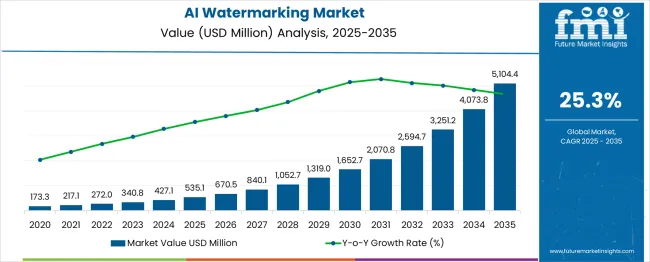
The revenue path highlights significant jumps, with values crossing USD 2,070.8 million in 2031 and surpassing USD 4,073.8 million in 2034. This growth rate indicates a fundamental shift in how organizations perceive intellectual property protection in an AI-dominated environment. The demand for watermarking solutions is driven not only by regulatory frameworks but also by enterprises seeking to preserve brand credibility and minimize the risks of misuse.
| Metric | Value |
|---|---|
| Estimated Value in (2025E) | USD 535.1 million |
| Forecast Value in (2035F) | USD 5,104.4 million |
| Forecast CAGR (2025 to 2035) | 25.3% |
The AI watermarking market has been evolving as a significant branch within broader digital ecosystems, and its relevance has been increasing across multiple industries where authenticity, traceability, and security are critical. Within the artificial intelligence market, AI watermarking accounts for around 4.8%, as companies embed invisible signatures into AI-generated outputs to distinguish authentic content from manipulated or deepfake material. In the digital rights management market, the segment represents nearly 6.1%, since watermarking strengthens intellectual property protection for publishers, creators, and software developers. The cybersecurity market has observed close to 5.5% share contributed by AI watermarking, as enterprises rely on it to safeguard sensitive information, digital assets, and ensure accountability in data flows.
Within the media and entertainment technology market, AI watermarking accounts for approximately 5.9%, as streaming platforms, gaming providers, and broadcasters utilize it to safeguard content ownership and reduce piracy. In the cloud computing market, the segment holds approximately 4.6%, owing to the embedding of watermarking into scalable cloud-based services that store and distribute AI-generated data.
Modern content creators and media companies are increasingly focused on protecting their digital assets while ensuring proper attribution and preventing unauthorized distribution. AI watermarking's proven ability to embed imperceptible identifiers while maintaining content quality makes it an essential technology for digital content protection and copyright enforcement.
The growing emphasis on combating deepfakes and synthetic media manipulation is driving demand for AI watermarking solutions that can verify content authenticity and detect tampering. Media companies' preference for solutions that combine robust protection with seamless integration into existing workflows is creating opportunities for innovative AI watermarking implementations. The rising influence of digital platforms and social media in content distribution is also contributing to increased adoption of watermarking technologies that can track and protect content across multiple channels.
The market is segmented by type, technology, deployment, application, end use, and region. By type, the market is divided into invisible watermarking and visible watermarking. Based on technology, the market is categorized into non-reversible watermarking and reversible watermarking. In terms of deployment, the market is segmented into cloud and on-premises. By application, the market is classified into copyright protection, authentication & security, branding & marketing, and others. By end use, the market is divided into media & entertainment, healthcare, BFSI, government & defense, retail & e-commerce, and others. Regionally, the market is divided into North America, Europe, East Asia, South Asia & Pacific, Latin America, and the Middle East & Africa.
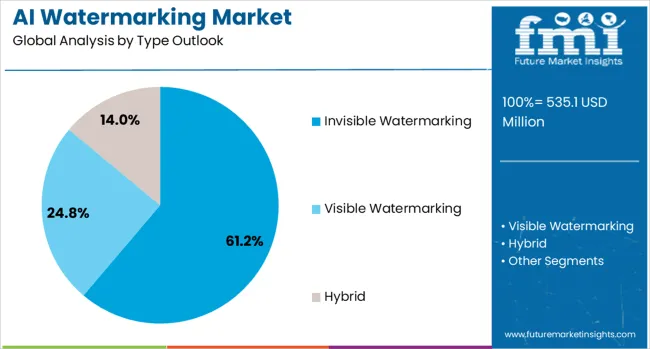
The invisible watermarking segment is projected to account for 61% of the AI watermarking market in 2025, reaffirming its position as the dominant watermarking approach. Content creators and media companies increasingly prefer invisible watermarking for its ability to protect content without compromising visual quality or user experience. Invisible watermarking's capability to embed robust identification information while maintaining imperceptible presence directly addresses industry requirements for seamless content protection that doesn't interfere with content consumption or aesthetic appeal.
This watermarking type forms the foundation of most digital content protection strategies, as it represents the most sophisticated and user-friendly approach to content security across multiple media formats and distribution channels. Technology provider investments in advanced AI algorithms and steganographic techniques continue to strengthen market adoption. With content owners prioritizing protection effectiveness without quality degradation, invisible watermarking aligns with both security requirements and user experience considerations, making it the central component of comprehensive content protection solutions.
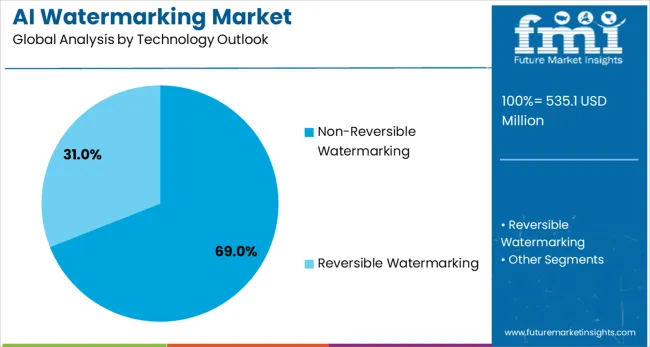
Non-reversible watermarking is projected to represent 69% of AI watermarking demand in 2025, underscoring its critical role in permanent content protection and copyright enforcement. Content owners prefer non-reversible watermarking for its ability to provide permanent identification markers that cannot be removed without significant content degradation. Positioned as essential technology for high-value content protection, non-reversible watermarking offers both security robustness and legal enforceability benefits for intellectual property protection.
The segment is supported by increasing requirements for tamper-proof content identification and growing legal precedents supporting watermark-based copyright enforcement. Additionally, content distributors are investing in non-reversible watermarking systems that can provide definitive proof of ownership and unauthorized usage. As content piracy becomes more sophisticated, non-reversible watermarking will continue to dominate the market while supporting comprehensive intellectual property protection strategies.
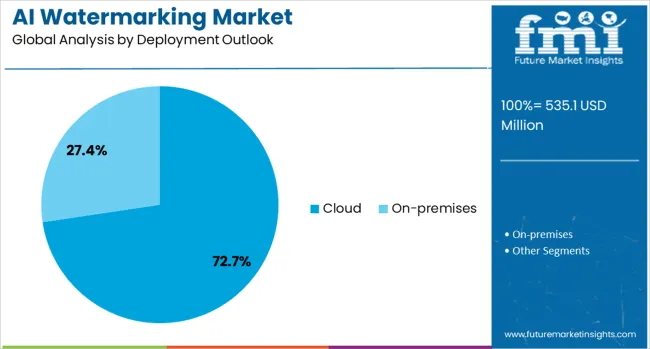
The cloud deployment segment is forecasted to contribute 73% of the AI watermarking market in 2025, reflecting the growing preference for scalable and accessible watermarking solutions. Organizations increasingly prefer cloud-based watermarking services for their scalability, cost-effectiveness, and ability to integrate with existing digital workflows without significant infrastructure investment. This aligns with digital transformation trends that emphasize cloud-first approaches for technology deployment and content management.
The segment benefits from continuous cloud infrastructure improvement and growing enterprise confidence in cloud security and performance capabilities. With established service provider ecosystems and flexible pricing models, cloud-based AI watermarking serves as the preferred deployment approach for organizations seeking comprehensive content protection capabilities, making it a critical foundation for market accessibility and widespread adoption.

The copyright protection application is forecasted to contribute 39% of the AI watermarking market in 2025, reflecting the primary driver of watermarking technology adoption. Content creators and media companies increasingly utilize AI watermarking for protecting intellectual property rights and preventing unauthorized content distribution across digital platforms. This aligns with intellectual property protection trends that emphasize proactive measures for content security and ownership verification.
The segment benefits from growing legal recognition of watermarking technology in copyright enforcement and increasing awareness of the impact of digital piracy on content industries. With established legal frameworks and enforcement mechanisms, copyright protection serves as the primary application for AI watermarking solutions, making it a critical component of digital content monetization and intellectual property management strategies.
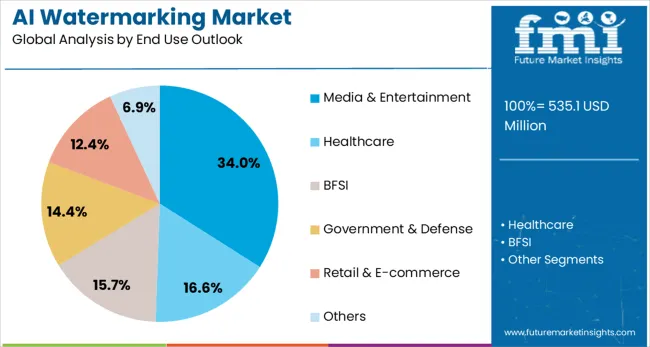
The media & entertainment end-use segment is forecasted to contribute 34% of the AI watermarking market in 2025, reflecting the industry's leadership in adopting advanced content protection technologies. Media companies increasingly invest in AI watermarking to protect valuable content assets, including movies, music, images, and streaming content, from piracy and unauthorized distribution. This aligns with entertainment industry trends that emphasize digital content security as a core business requirement.
The segment benefits from high-value content assets requiring sophisticated protection and established industry practices supporting watermarking technology adoption. With significant revenue impact from content piracy and growing digital distribution channels, media & entertainment serves as the primary market for AI watermarking solutions, making it a critical foundation for technology development and market growth.
The AI watermarking market has been influenced by growing concerns over digital authenticity, copyright protection, and misinformation management. Demand has been reinforced by governments, media outlets, and enterprises seeking trusted solutions for identifying AI-generated content. Opportunities are emerging in content licensing, compliance-driven deployments, and cross-industry collaborations. Trends point toward integration with generative AI platforms, blockchain-enabled tracking, and real-time monitoring frameworks. However, significant challenges persist around interoperability, performance limitations, and regulatory uncertainties, which may slow down adoption despite the strong recognition of watermarking as a safeguard for digital ecosystems.
The AI watermarking market has been shaped by emerging trends revolving around direct integration with generative AI models, blockchain-enabled verification, and real-time content tracking. Watermarking has been increasingly embedded into text-to-image and text-to-video generation platforms to ensure that each piece of synthetic content can be identified with precision. Blockchain has been highlighted as an enabling layer for tamper-proof watermark tracking and auditability. Another trend being reinforced is the use of real-time monitoring frameworks that allow enterprises to detect manipulated or redistributed content across multiple channels. These trends reflect a market that is not only reacting to threats but also actively reshaping how AI content is managed and distributed. It is clear that AI watermarking is moving toward a default security layer in generative AI ecosystems, with adoption accelerating in creative, enterprise, and regulatory landscapes.
The AI watermarking market has been restricted by challenges that include interoperability barriers, performance inconsistencies, and uncertainty in global regulatory alignment. Watermarking tools from different providers often lack standardization, making cross-platform validation unreliable. Performance issues such as watermark fragility under compression, editing, or adversarial attacks raise concerns about practical usability. Legal uncertainties further complicate adoption, as different jurisdictions impose varying degrees of disclosure requirements for AI-generated content. Enterprises are also hesitant to adopt solutions that may become obsolete if regulations shift rapidly.
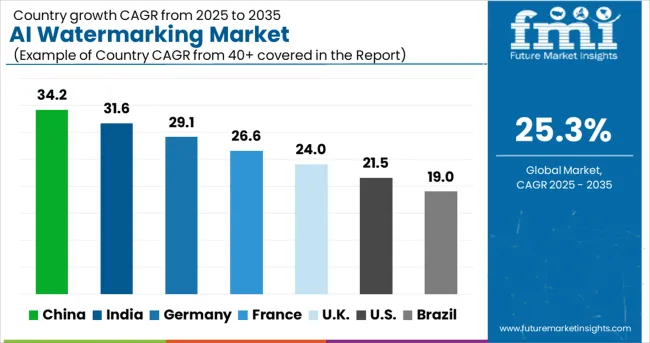
| Country | CAGR (2025-2035) |
|---|---|
| China | 34.2% |
| India | 31.6% |
| Germany | 29.1% |
| France | 26.6% |
| United Kingdom | 24% |
| United States | 21.5% |
| Brazil | 19% |
The global AI watermarking market between 2025 and 2035 is projected to display accelerated growth across multiple economies, with leading nations setting different momentum levels. China leads with a CAGR of 34.2%, followed by India at 31.6% and Germany at 29.1%. France records 26.6%, while the United Kingdom expands at 24%. The United States posts 21.5%, and Brazil follows with 19%. Growth is being reinforced by rising demand for digital content authentication, regulatory pressure to identify AI-generated media, and adoption of watermarking tools across creative, security, and enterprise sectors. Emerging economies such as China and India register higher adoption due to rapid AI deployment and content-heavy digital ecosystems, while developed markets emphasize compliance, enterprise-level security, and ethical AI integration.
The report covers an in-depth analysis of 40+ countries; the top-performing countries are highlighted below.
The AI watermarking market in China is expanding at a CAGR of 34.2%, supported by strong adoption in social media platforms, e-commerce, and video-sharing ecosystems. Chinese enterprises are integrating watermarking tools to ensure authenticity of AI-generated content and comply with evolving digital regulations. Government directives around content integrity and rising cases of misinformation are creating heightened demand for AI-based watermarking. China’s vast digital user base and the dominance of local technology platforms further accelerate implementation, making the country a global frontrunner in this market.
The AI watermarking market in India is projected to grow at 31.6%, fueled by the expansion of digital entertainment, fintech, and e-learning platforms. Indian companies are adopting AI watermarking solutions to prevent fraud, ensure compliance, and protect intellectual property. Growth is supported by regulatory attention to misinformation and the need for verified digital identities. Increasing internet penetration, mobile-first consumption, and multilingual digital ecosystems create stronger demand for watermarking technologies. Collaboration between startups and global AI leaders further enhances innovation and large-scale deployment in the Indian market.
The AI watermarking market in Germany is advancing at a CAGR of 29.1%, driven by adoption in industrial automation, financial services, and media publishing. German enterprises are deploying AI watermarking systems to authenticate digital outputs, protect enterprise data, and meet strict compliance frameworks. Regulatory oversight on AI-generated media is shaping adoption patterns, especially in news and advertising sectors. Government support for ethical AI development, coupled with strong enterprise focus on data authenticity, reinforces demand. Germany’s emphasis on precision, reliability, and enterprise-grade applications makes it one of Europe’s key markets.
The AI watermarking market in France is growing at 26.6%, supported by adoption across media, government communication, and retail platforms. French organizations are deploying watermarking tools to ensure accountability, verify AI-generated materials, and manage data privacy concerns. National digital strategies emphasizing AI regulation strengthen market penetration. France’s research institutions and innovation hubs contribute to advancements in watermarking algorithms, which are increasingly being applied in creative industries and enterprise solutions.
The AI watermarking market in the United Kingdom is set to expand at 24%, driven by rising concerns over deepfake content, media accountability, and data authenticity. UK enterprises are integrating AI watermarking into enterprise solutions, media outlets, and public sector communication. The presence of global AI players and government-backed regulatory initiatives supports market expansion. Adoption is also being reinforced by financial institutions and academic ecosystems, which are increasingly deploying watermarking to ensure integrity of digital assets.

The AI watermarking market in the United States is growing at 21.5%, supported by enterprise adoption across healthcare, finance, and media sectors. USA organizations are implementing watermarking to safeguard intellectual property, ensure content authenticity, and comply with evolving ethical AI standards. Adoption is reinforced by investments in AI startups, R&D efforts, and regulatory debates around generative AI. While growth rates are slower than in Asia, the USA remains a central hub for watermarking technology innovation, especially in deep learning and multimedia verification.
The AI watermarking market in Brazil is projected to expand at 19%, fueled by the rise of social media usage, digital banking, and entertainment platforms. Brazilian enterprises are integrating watermarking to protect users against misinformation, secure financial transactions, and enhance consumer trust in digital content. Increasing smartphone penetration and government efforts to regulate AI-generated content reinforce growth. Local businesses are also collaborating with international AI vendors to strengthen watermarking deployments in multiple sectors.
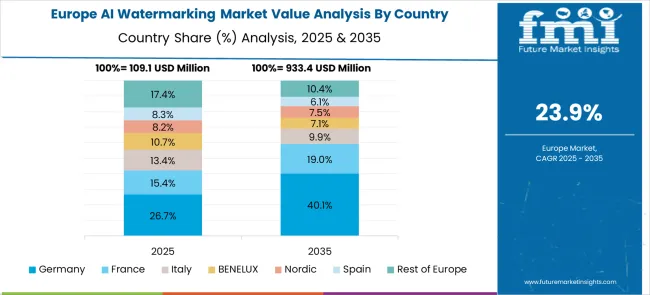
The AI watermarking market in Europe demonstrates advanced development across major economies, with Germany showing a strong presence through its technology sector expertise and emphasis on digital content protection and intellectual property rights, supported by companies leveraging engineering excellence to develop sophisticated AI watermarking solutions that emphasize security, reliability, and integration capabilities for media and enterprise applications.
France represents a significant market driven by its media industry heritage and sophisticated understanding of content protection requirements, with companies focusing on innovative AI watermarking solutions that combine French creative industry expertise with advanced artificial intelligence technologies for enhanced content security and copyright protection in entertainment and digital media applications.
The UK exhibits considerable growth through its emphasis on digital innovation and content industry leadership, with strong adoption of AI watermarking in media companies, broadcasting organizations, and digital platforms. Germany and France show expanding interest in enterprise AI watermarking applications, particularly in financial services and healthcare sectors requiring advanced content authentication. BENELUX countries contribute through their focus on technology innovation and digital content security. At the same time, Eastern Europe and the Nordic regions display growing potential driven by increasing digital content creation and expanding adoption of advanced content protection technologies.
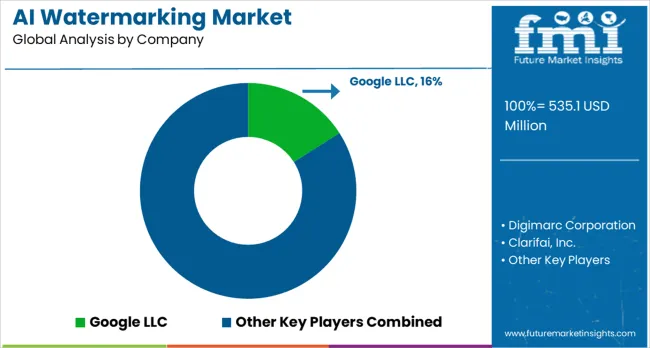
The AI watermarking market is driven by technology providers, cybersecurity firms, and digital content protection specialists offering advanced solutions for image, video, and document security. Leading players such as Adobe, Digimarc, MarkAny, Zypher Technologies, and Verimatrix maintain strong positions by delivering AI-powered watermarking solutions that integrate machine learning, deep learning, and pattern recognition to protect intellectual property and verify content authenticity. Competitive differentiation is primarily shaped by watermark robustness, imperceptibility, real-time embedding, detection accuracy, and scalability across digital platforms.
Emerging regional players focus on niche applications such as OTT media, e-learning content, and enterprise document security, providing customizable, cost-efficient, and cloud-compatible watermarking solutions. Strategic collaborations with content distributors, media platforms, and cloud service providers enhance technology adoption and expand market reach. Continuous innovation in AI-based steganography, tamper-proof watermarking, and automated copyright verification strengthens market positioning. Companies prioritizing cybersecurity standards, regulatory compliance, and seamless integration with existing digital ecosystems are well-positioned to capture significant market share.
| Items | Values |
| Quantitative Units (2025) | USD 535.1 million |
| Type | Invisible Watermarking, Visible Watermarking |
| Technology | Non-Reversible Watermarking, Reversible Watermarking |
| Deployment | Cloud, On-premises |
| Application | Copyright Protection, Authentication & Security, Branding & Marketing, Others |
| End Use | Media & Entertainment, Healthcare, BFSI, Government & Defense, Retail & E-commerce, Others |
| Regions Covered | North America, Europe, East Asia, South Asia & Pacific, Latin America, Middle East & Africa |
| Countries Covered | United States, Canada, United Kingdom, Germany, France, China, Japan, South Korea, India, Brazil, Australia and 40+ countries |
| Key Companies Profiled | Google LLC, Digimarc Corporation, Clarifai Inc., Beijing Kuangshi Technology Co. Ltd., ZOO Digital Group plc, IMATAG, Kantar Media, Vobile Group Limited, Verimatrix, and MarkAny Co. Ltd. |
| Additional Attributes | Dollar sales by type and end-use category, regional demand trends, competitive landscape, buyer preferences for invisible versus visible watermarking, integration with content management systems, innovations in deep learning algorithms, blockchain integration advancement, and real-time watermarking solution development |
United States
Canada
Mexico
Germany
United Kingdom
France
Italy
Spain
Nordic
BENELUX
Rest of Europe
China
Japan
South Korea
India
ASEAN
Australia & New Zealand
Rest of South Asia & Pacific
Brazil
Chile
Rest of Latin America
Kingdom of Saudi Arabia
Other GCC Countries
Turkiye
South Africa
Other African Union
Rest of Middle East & Africa
The global AI watermarking market is estimated to be valued at USD 535.1 million in 2025.
The market size for the AI watermarking market is projected to reach USD 5,104.4 million by 2035.
The AI watermarking market is expected to grow at a 25.3% CAGR between 2025 and 2035.
The key product types in AI watermarking market are invisible watermarking, visible watermarking and hybrid.
In terms of technology outlook, the non-reversible watermarking segment is expected to command 69.0% share in the AI watermarking market in 2025.






Our Research Products

The "Full Research Suite" delivers actionable market intel, deep dives on markets or technologies, so clients act faster, cut risk, and unlock growth.

The Leaderboard benchmarks and ranks top vendors, classifying them as Established Leaders, Leading Challengers, or Disruptors & Challengers.

Locates where complements amplify value and substitutes erode it, forecasting net impact by horizon

We deliver granular, decision-grade intel: market sizing, 5-year forecasts, pricing, adoption, usage, revenue, and operational KPIs—plus competitor tracking, regulation, and value chains—across 60 countries broadly.

Spot the shifts before they hit your P&L. We track inflection points, adoption curves, pricing moves, and ecosystem plays to show where demand is heading, why it is changing, and what to do next across high-growth markets and disruptive tech

Real-time reads of user behavior. We track shifting priorities, perceptions of today’s and next-gen services, and provider experience, then pace how fast tech moves from trial to adoption, blending buyer, consumer, and channel inputs with social signals (#WhySwitch, #UX).

Partner with our analyst team to build a custom report designed around your business priorities. From analysing market trends to assessing competitors or crafting bespoke datasets, we tailor insights to your needs.
Supplier Intelligence
Discovery & Profiling
Capacity & Footprint
Performance & Risk
Compliance & Governance
Commercial Readiness
Who Supplies Whom
Scorecards & Shortlists
Playbooks & Docs
Category Intelligence
Definition & Scope
Demand & Use Cases
Cost Drivers
Market Structure
Supply Chain Map
Trade & Policy
Operating Norms
Deliverables
Buyer Intelligence
Account Basics
Spend & Scope
Procurement Model
Vendor Requirements
Terms & Policies
Entry Strategy
Pain Points & Triggers
Outputs
Pricing Analysis
Benchmarks
Trends
Should-Cost
Indexation
Landed Cost
Commercial Terms
Deliverables
Brand Analysis
Positioning & Value Prop
Share & Presence
Customer Evidence
Go-to-Market
Digital & Reputation
Compliance & Trust
KPIs & Gaps
Outputs
Full Research Suite comprises of:
Market outlook & trends analysis
Interviews & case studies
Strategic recommendations
Vendor profiles & capabilities analysis
5-year forecasts
8 regions and 60+ country-level data splits
Market segment data splits
12 months of continuous data updates
DELIVERED AS:
PDF EXCEL ONLINE
AI Code Assistant Market Size and Share Forecast Outlook 2025 to 2035
AI-Based Data Observability Software Market Size and Share Forecast Outlook 2025 to 2035
Air Fryer Paper Liners Market Size and Share Forecast Outlook 2025 to 2035
Air Struts Market Size and Share Forecast Outlook 2025 to 2035
AI-powered Wealth Management Solution Market Size and Share Forecast Outlook 2025 to 2035
Airless Paint Spray System Market Size and Share Forecast Outlook 2025 to 2035
AI Powered Software Testing Tool Market Size and Share Forecast Outlook 2025 to 2035
AI Document Generator Market Size and Share Forecast Outlook 2025 to 2035
AI in Fintech Market Size and Share Forecast Outlook 2025 to 2035
Air Caster Skids System Market Size and Share Forecast Outlook 2025 to 2035
AI-Driven HD Mapping Market Size and Share Forecast Outlook 2025 to 2035
AI Platform Market Size and Share Forecast Outlook 2025 to 2035
AI-powered Spinal Surgery Market Size and Share Forecast Outlook 2025 to 2035
AI-Powered Sleep Technologies Market Size and Share Forecast Outlook 2025 to 2035
AI-Powered Gait & Mobility Analytics Market Size and Share Forecast Outlook 2025 to 2035
AI-Powered Behavioral Therapy Market Size and Share Forecast Outlook 2025 to 2035
AI-Enabled Behavioral Therapy Market Size and Share Forecast Outlook 2025 to 2035
AI-powered In-car Assistant Market Forecast and Outlook 2025 to 2035
Airborne Molecular Contamination Control Services Market Forecast and Outlook 2025 to 2035
Airflow Balancer Market Size and Share Forecast Outlook 2025 to 2035

Thank you!
You will receive an email from our Business Development Manager. Please be sure to check your SPAM/JUNK folder too.
Chat With
MaRIA